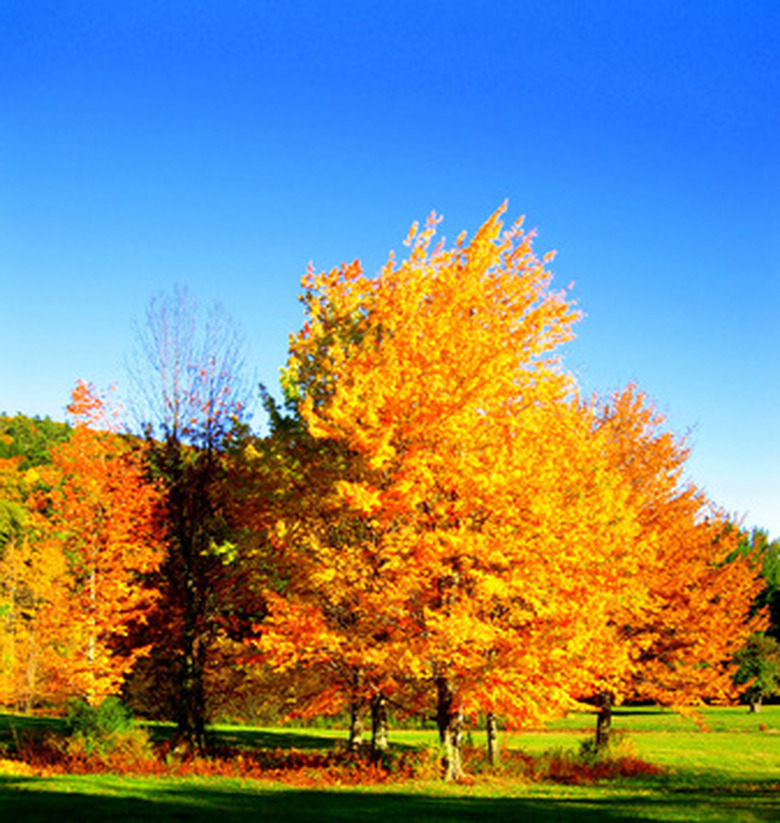Deborah Maple Tree Diseases
The Deborah maple or Deborah Norway maple is the Acer platanoides species of the maple tree family. Similar to most maples, this deciduous tree has a moderate to fast growth rate and adaptable soil tolerance. It can reach mature heights up to 90 feet and produces simple, dark green foliage with small, yellowish green spring blooms and fall color. Though resistant to many diseases, the Deborah maple is susceptible to several tree diseases that can be injurious when left untreated.
Crown Gall
Crown Gall is a bacterial disease that infects a wide array of trees. The bacterium enters the Deborah maple through open wounds or cracks in the wood. Crown gall disease infects the tissue of the wood; first at the point of infection and then spreading throughout the tree. The infection produces a tan-colored gall that darkens as the disease progresses. Initially soft and spongy, the gall will harden with age and girdle the tree. Galls generally form near the graft union line near the soil and near the bud union on stems and twigs. Crown gall is contagious and can be easily spread from the tree to other vegetation. No bactericide exists for crown gall infections. Infected Deborah maple trees should be removed and destroyed.
- The Deborah maple or Deborah Norway maple is the Acer platanoides species of the maple tree family.
- Crown gall disease infects the tissue of the wood; first at the point of infection and then spreading throughout the tree.
Bacterial Wetwood
Bacterial wetwood infects the central core and bark of the Deborah maple tree. This bacterial disease is caused by several types of bacteria that join together. The bacterium enters the tree through open-wounded and newly-pruned areas. Infected maple trees will display yellowish brown wood near the center of the tree's trunk. The infected area will appear water-soaked and ooze a foul-smelling, slimy discharge that results from the infected area's high internal gas pressure. The slime is toxic to the tree's wood, foliage and stems. Foliage and blooms will die if subjected to the slime. As the slime dries and gas pressures decline, the bark and wood will begin to crack and split. Deborah Norway maple trees should be kept properly irrigated and fertilized to maintain growing vigor and prevent infection. Bacterial treatments are not able to control or prevent the spread of this bacterial disease. Severely infected trees should be removed and discarded.
- Bacterial wetwood infects the central core and bark of the Deborah maple tree.
- The slime is toxic to the tree's wood, foliage and stems.
Tar Spot
Tar spot is a fungal disease that infects the foliage of the Deborah maple tree. The disease develops on defoliated debris that remains on the ground during the winter months. During the spring, the fungal spores infect the foliage of the tree. Foliage will initially develop small, pale yellow spots that turn black as the disease progresses. The blackened spots will continue to grow and thicken, merging into a larger black mass of infection. Tar spot does not cause terminal damage to the Deborah maple, but the tree may experience premature defoliation. Repeated seasons of defoliation may weaken the tree and result in stunted growth. Tar spot can be controlled by keeping the tree's area free of debris and fallen foliage. Fungicidal sprays are effective in controlling the disease but require the complete coverage of the tree.
- Tar spot is a fungal disease that infects the foliage of the Deborah maple tree.
- Fungicidal sprays are effective in controlling the disease but require the complete coverage of the tree.
